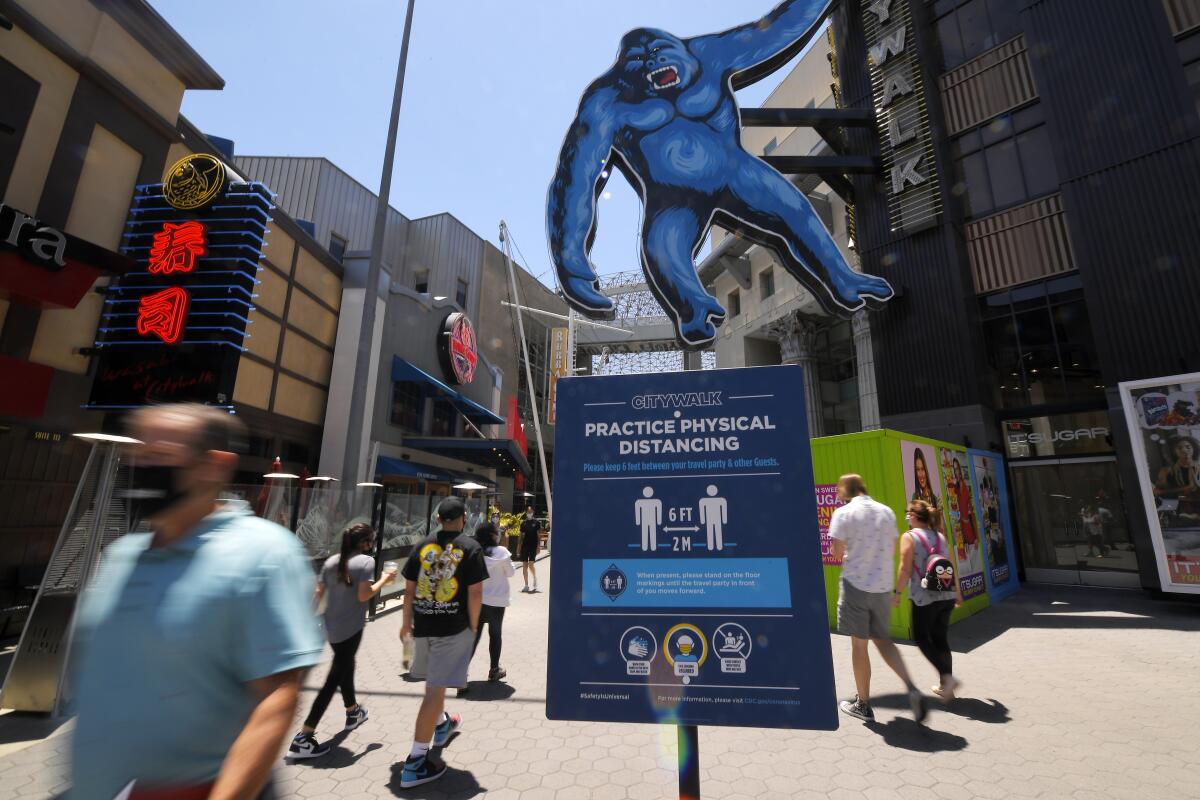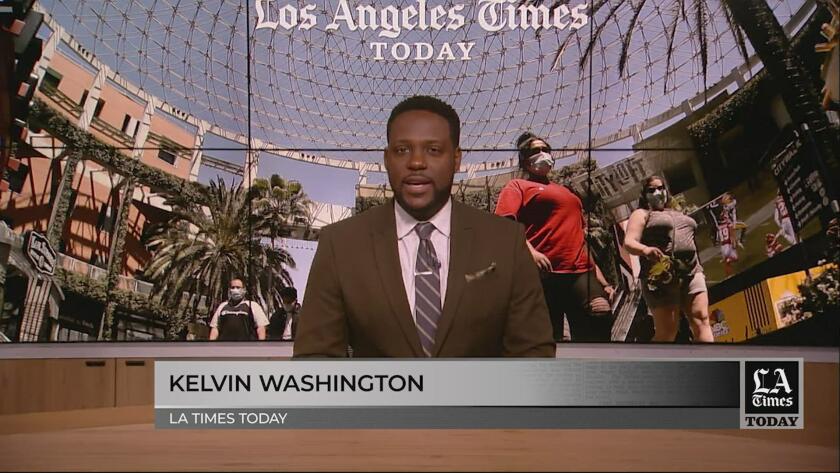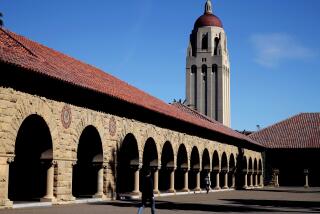California’s economic recovery will be like a slow ‘Nike swoosh’

- Share via
California is unlikely to recover its pre-coronavirus prosperity over the next three years, economists say, even as the state slowly rebuilds from a catastrophic economic lockdown.
The Golden State’s gradual recovery will probably mirror the nation’s trajectory, according to a new UCLA forecast.
“The public health crisis of the pandemic morphed into a depression-like crisis in the [U.S.] economy,” wrote David Shulman, a senior economist at UCLA Anderson Forecast.
The trajectory of the nation’s economy will be like a “Nike swoosh,” Shulman wrote: Real gross domestic product will plunge this quarter — at a 42% annual rate — and then gradually rise, not returning to its late-2019 peak until early 2023.
Even that gradual return to normal activity is based on a somewhat optimistic scenario — that the COVID-19 pandemic will subside, avoiding a pause in the recovery or another wave of shutdowns.
“The strong assumption is the abatement of the pandemic this summer,” wrote Jerry Nickelsburg, director of the UCLA Anderson Forecast. “But we must keep in mind that the pandemic assumption is just that: an assumption.”
California’s unemployment rate, which was 16.3% in May, will average out to 10.5% for the year, the forecast estimated. It will drop to 8.2% in 2021 and to 6.8% in 2022, it predicted.
By comparison, in February — before the pandemic slammed the state’s economy — the jobless rate was 3.9%.
Two other forecasts suggest a somewhat slower bounce-back for the Golden State this year.
“Even with the recovery, there will be 800,000 fewer jobs in California by the fourth quarter as compared to the first quarter” of 2020, according to a Chapman University outlook released this week. It predicts an average 11.3% unemployment rate this year.
Beneath the fury over George Floyd’s death lie longstanding economic inequities that have plagued California’s 2.6 million black people.
Nonetheless, the Chapman economists suggested, the post-pandemic comeback could be “rapid” compared with the recovery from the Great Recession, which “dragged on for seven quarters.”
Scott Anderson, chief economist at the Bank of the West predicts California joblessness will average 11.5% this year, 9.8% in 2021 and 7.3% in 2022.
“California business shutdowns have been longer lasting and more severe than many states,” said Anderson said. “The recovery in leisure and hospitality and trade will likely be slower than the nation. And high costs of living convince more folks to leave the state for greener pastures: regions with better job prospects and lower living costs.”
Beyond the private-sector effects, Anderson noted the collapse in state income and sales tax revenues.
“Like an earthquake, this is only the start,” he wrote in the bank’s June forecast. “State and local spending is expected to fall sharply to help balance the state budget, further weighing on California’s job creation.”
The UCLA forecast expects a sluggish trajectory for personal income in California, which would drop 0.9% this year, rising just 1.4% next year and 2.2% in 2022.
Employers won’t be quick to add new jobs. The UCLA forecast expects payrolls in California to shrink 9.3% overall this year, then grow at 0.4% next year and 6.6% the year after.
The COVID-19 pandemic is unleashing a wave of labor unrest harnessing front-line workers’ fear and anger across California and the nation.
From February to April, California lost 2.56 million payroll jobs, a 15% loss. That’s more severe than the job losses caused by the Great Recession of 2007-09, when the state shed 1.3 million positions, or 8%, over 26 months.
Unlike that recession, which was driven by an unprecedented decline in the construction industry, two sectors — leisure and hospitality as well as retail — drove this year’s pandemic-caused meltdown, accounting for half of the lost jobs.
As restaurants, event spaces and tourist attractions reopen, those jobs won’t all come back, the UCLA forecast predicted.
“The COVID-19 pandemic has created a sense of caution on the part of the general public, both within California and among tourists who might come to the state,” the UCLA forecast said. “Potential customers for these businesses will want to feel safe before venturing out.”
By the end of 2022, it predicted, the leisure and hospitality sector would remain 20% below its previous peak.
“That translates to 200,000 relatively low-income Californians with long-term unemployment for 30 months,” the forecast said. “Some will find employment in other sectors, but in an economy that is demanding technical skills, it will be challenging.”
Retail employment, battered by the rise of online shopping and the bankruptcies of bricks-and-mortar chains, may also remain 20% below pre-pandemic levels, the UCLA forecast suggested, with 160,000 fewer jobs.. But it emphasized the uncertainty of its prediction: “It depends in a crucial way as to what happens when the economy opens up. Do consumers go back to the mall, or do they shun it?”
Chapman’s forecast noted that the concentration of job losses in retail, restaurants, hotels and other tourism-related businesses means a smaller loss in earnings than if the jobs were, for example, in construction or technology.
Workers in retail and leisure and hospitality earn relatively low wages — about half the statewide average. “Because of that, the economic damage to the state will be far less than that implied by the huge job losses,” according to the Chapman forecast.
Construction is expected to rebound fairly rapidly, and “the average annual salary for a construction worker is $71,300 versus $30,400 in leisure and hospitality,” the Chapman economists wrote. And information services, a California industry that has remained stable, “commands an average salary of $187,200 versus $68,400 for all industries.”
UCLA economists predicted healthcare and social services, where medical and dental offices and childcare venues suffered steep losses, would recoup jobs “much more rapidly” than retail or leisure and hospitality.
“Medical offices will be moving back to normal as they institute protocols that will assure their patients of safety during visits,” the UCLA economists wrote. And as for childcare, even though more people than usual will be working from home, “that might not diminish the need for childcare as a distraction-free environment may be desired.”
- Share via
Watch LA Times Today at 7 PM/10PM on channel 1 on Spectrum News 1, and on Cox systems in Palos Verdes and Orange County on channel 99.
Comparing California with the overall United States, the UCLA forecast said the state’s disproportionate reliance on international tourism would mean a somewhat slower recovery in leisure and hospitality and retail. Transportation and warehousing sectors could also see a more sluggish return in California than nationwide because of the U.S.-China trade war, which disproportionately affects California’s massive ports.
On the other hand, the Golden State should recover faster than the overall nation in business, scientific and technical services and in the information sector “due to the demand for new technologies for the new way we are working and socializing.”
For example, Nickelsburg suggested, “there will be new technologies for people working at home. And there is telemedicine.”
As for the housing sector, UCLA’s forecast projected the building of 94,000 new units in California this year, down 17.3% from last year.
“In spite of the recession, the continued demand for a limited housing stock coupled with low-interest rates leads to a forecast of a relatively rapid return of home-building,” Nickelsburg wrote. But even with many construction jobs returning, he said, “the prospect for the private sector building out of the housing affordability problem over the next three years is nil.”
In an article accompanying the forecast, economist Leila Bengali suggested that “the pandemic has had small, though generally negative, effects on housing markets as of March 2020 …. [It] may shift consumer preferences towards single-family, lower density homes and away from denser multifamily homes, particularly if consumers are able to live further from their employer’s location.”
And if the state’s Tenant Protection Act, which took effect in January, “negatively affects landlords’ business costs and revenues, they might respond by exiting the rental market, reducing the supply of homes for rent but potentially increasing the supply of homes for sale if property conversions occur quickly.”
The pandemic’s effect and tenant protection laws across the country “are becoming interconnected as cities and states pass moratoria on evictions for non-payment of rent,” she added.
More to Read
Inside the business of entertainment
The Wide Shot brings you news, analysis and insights on everything from streaming wars to production — and what it all means for the future.
You may occasionally receive promotional content from the Los Angeles Times.














